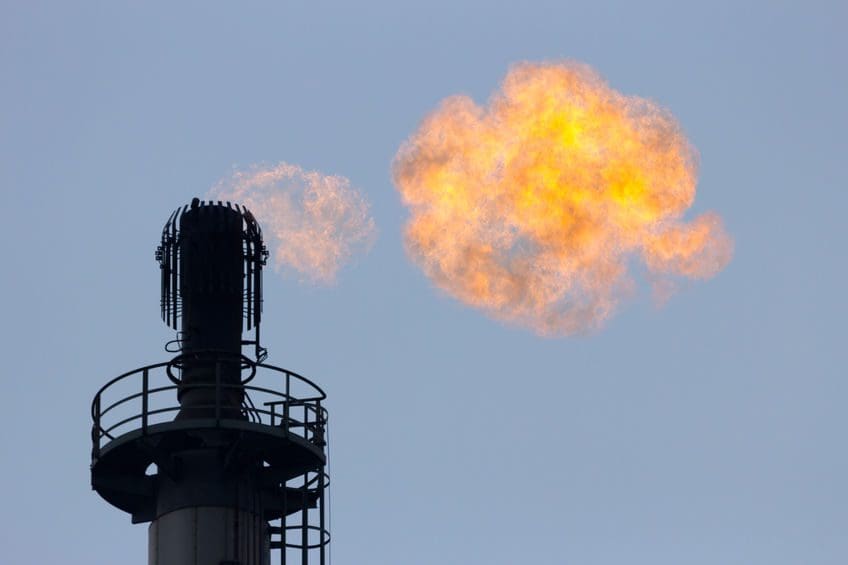Austin, Texas – Today Texas Railroad Commissioner Ryan Sitton released a report highlighting data on flaring volumes from the oil and natural gas industry. The report examines the relationship between oil production and flaring and offers a new metric referred to as flaring intensity. As stated in the report, by measuring flaring intensity of nations, states and companies, and comparing them all to the global industry average, Commissioner Sitton is now offering a benchmark on performance. His office plans to update and publish the report on a quarterly basis.
The new report issued by Texas Railroad Commissioner Ryan Sitton shows that the U.S. oil and natural gas industry ranks second globally for the lowest flaring intensity (U.S.: 0.11 Mcf/Bbl vs. World: 0.14 Mcf/Bbl), which is based on a metric that relates to the amount of gas flared to the amount of oil produced. Texas also leads the country with the lowest flaring intensity (0.09 Mcf/Bbl), even as production has reached historic levels. The increase in flaring is due in large part to a lack of adequate infrastructure with wells producing higher levels of associated gas with no access to the systems required to capture that gas. As outlined in the report from Commissioner Sitton, while Texas flaring volumes are at a high for recent history, current levels are not unprecedented. And though Texas’ flaring intensity has trended up since the 1980s, the state as a whole is still well below historical levels and most of the world.
Additional data and analysis are welcome on the topic of flaring, as are constructive conversations and collaboration between all stakeholders. In Texas, over 90 percent of natural gas is captured in gathering systems and transported by pipeline to processing facilities. We can expect a decrease in flaring volume and intensity as additional pipeline capacity comes online, coupled with a reduction in drilling activity related to capital constraints and other market challenges. As stated in the report, with flaring intensity levels in Texas already lower than most of the world’s oil and gas producing countries, and lower than historical levels, forcing a reduction could actually cause an increase in flaring overseas, while having a negative impact on domestic energy development and the tremendous economic benefit the industry provides at the state and national level.
On the larger topic of energy production, emissions and the environment, today America is among the leaders in the world for clean air, water and proactive environmental stewardship, even with record production of oil and natural gas. In fact, methane emissions from onshore U.S. oil and natural gas production dropped 24 percent, while oil and natural gas production rose 65 percent and 19 percent, respectively, from 2011 to 2017, according to data from the U.S. Environmental Protection Agency and the Energy Information Administration.
The International Energy Agency (IEA) also reported this week that U.S. carbon emissions fell by 2.9 percent, or by 140 million tons, in 2019, continuing the trend of the U.S. leading the world in total emissions decline since 2000. Unfortunately, emissions in the rest of the world grew by nearly 400 million tons, with 80 percent of that increase coming from developing countries in Asia due to strong demand for coal. The IEA stated that the decline in emissions in the U.S, Japan and the European Union was mainly due to using less coal for electricity, replacing it with natural gas and other forms of energy.
These positive energy emission trends are also attributable to voluntary actions taken by U.S. operators, including investment of over $300 billion in greenhouse gas mitigating technologies by U.S. oil and natural gas companies over the past 20 years. Below are two of many examples of multi-stakeholder initiatives designed to improve the environmental performance of the oil and gas industry.
The Environmental Partnership: This initiative is comprised of companies from across the U.S. oil and natural gas industry that are committed to continuous improvement of the industry’s performance. In the area of methane management, the Environmental Partnership is implementing programs initially focused on leak detection and repair; replacement of outdated pneumatic controllers; and improving manual liquids unloading. This alliance also provides an important forum for America’s energy producers to collaborate on technological solutions to reduce air emissions and improve the overall environmental footprint of oil and natural gas operations.
Our Nation’s Energy Future (ONE Future): A coalition of companies dedicated to continuous improvement in the management of methane emissions across the natural gas value chain. Member companies involved with ONE Future have committed to reducing the average methane leakage rate across all of their participating U.S. facilities to below 1 percent by 2025. One Future is already well ahead of that goal.
The United States meanwhile continues to dominate as a global leader in environmental success. Since 2005, the starting point for the Paris Climate Accords, total U.S. greenhouse gas (GHG) emissions have dropped by 12 percent and total GHG emissions from fossil fuel combustion have decreased nearly 15 percent. In the meantime, every one of the signatories of the Paris Accord lags behind America in overall emissions reductions. These are more examples of significant and measurable results being achieved by this sector that should be at least acknowledged by oil and natural gas detractors.
But that’s just the beginning. New technologies are again mapping the future for lower-emissions oil and gas production. In addition to voluntary programs, increased use of natural gas for electricity generation, and a massive investment in emission-reducing technologies, energy companies are pursuing new partnerships to further research and deploy innovative programs like carbon capture and sequestration (CCS). The U.S. Department of Energy is also running a carbon capture program, aiming to demonstrate technology that could capture CO2 for a cost of less than $40/metric ton between 2020 and 2025. This public-private sector approach is what’s needed to fully capitalize on our country’s extraordinary natural resources, while continuing to protect the environment for future generations.
Oil and gas is an industry defined by innovation and results. TIPRO looks forward to continuing its work with partners and stakeholders on realistic solutions, collaboration and innovation to reduce emissions. Cleaner operations, facilities and products all are part of this sector’s commitment to responsibly develop our nation’s energy resources.
About TIPRO
The Texas Independent Producers & Royalty Owners Association (TIPRO) is a trade association representing the interests of nearly 3,000 independent oil and natural gas producers and royalty owners throughout Texas. As one of the nation’s largest statewide associations representing both independent producers and royalty owners, members include small businesses, the largest, publicly-traded independent producers, and mineral owners, estates, and trusts.
TIPRO is a trade association representing the interests of nearly 3,000 independent oil and natural gas producers and royalty owners throughout Texas. As the largest statewide association in Texas that represents both independent producers and royalty owners, members include small businesses, the largest, publicly-traded independent producers, and mineral owners, estates, and trusts.






